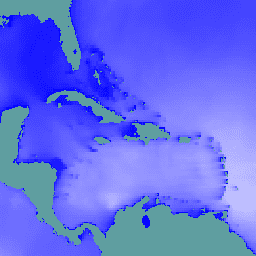
- Disponibilité de l'ensemble de données
- 2024-11-12T12:00:00Z–2025-12-18T12:00:00Z
- Fournisseur de l'ensemble de données
- ECMWF
- Cadence
- 12 heures
- Tags
Description
Cet ensemble de données contient des prévisions à 15 jours des champs du modèle de vagues générés par l'IFS (Integrated Forecasting System, système de prévision intégré) de l'ECMWF à une résolution de 0,25 degré. Nous parlons ici de "temps quasi réel" (NRT), car de nouveaux produits sont publiés deux fois par jour après la publication des données de prévision en temps réel de l'ECMWF, dont il s'agit d'un sous-ensemble. Les données peuvent être distribuées et utilisées à des fins commerciales avec une attribution appropriée.
Les produits sont disponibles dans Earth Engine à partir de l'implémentation du cycle 49r1 le 12 novembre 2024. Les produits antérieurs ne sont pas inclus. Pour obtenir des informations générales sur l'utilisation des ensembles de données ECMWF NRT, consultez leur documentation utilisateur. Les fichiers sources sont disponibles sur Google Cloud Marketplace.
Bandes
Taille des pixels
28 000 mètres
Bandes
| Nom | Unités | Min | Max | Taille des pixels | Description |
|---|---|---|---|---|---|
mean_zero_crossing_wave_period_sfc |
secondes | 0,889358* | 17,0074* | mètres | Durée moyenne entre les occasions où la surface de la mer/de l'océan franchit le niveau moyen de la mer. |
significant_height_of_combined_wind_waves_and_swell_sfc |
m | 0,0172079* | 15,7469* | mètres | Hauteur moyenne du tiers supérieur des vagues de surface de l'océan ou de la mer générées par le vent et la houle. Elle représente la distance verticale entre la crête et le creux de la vague. |
mean_wave_direction_sfc |
deg | 0 | 360 | mètres | Direction moyenne des vagues à la surface de l'océan ou de la mer par rapport à l'emplacement géographique du pôle Nord (par exemple, 0 signifie "venant du nord" et 90 signifie "venant de l'est"). |
peak_wave_period_sfc |
secondes | 1,03074* | 23,9353* | mètres | Période des vagues océaniques les plus énergiques qui sont générées par les vents locaux et associées à la houle. La période de la houle correspond au temps moyen nécessaire pour que deux crêtes de vagues consécutives passent par un point fixe à la surface de l'océan ou de la mer. |
mean_wave_period_sfc |
secondes | 1,04071* | 19,5239* | mètres | La période de la houle correspond au temps moyen nécessaire pour que deux crêtes de vagues consécutives passent par un point fixe à la surface de l'océan ou de la mer. |
Propriétés de l'image
Propriétés des images
| Nom | Type | Description |
|---|---|---|
| creation_day | INT | Jour du mois où la prévision a été créée. |
| creation_doy | INT | Jour de l'année où la prévision a été créée. |
| creation_hour | INT | Heure de la journée à laquelle la prévision a été créée. |
| creation_month | INT | Mois de l'année où la prévision a été créée. |
| creation_time | INT | Heure (en millisecondes depuis l'epoch Unix) à laquelle la prévision a été créée. |
| creation_year | INT | Année de création de la prévision. |
| forecast_hours | INT | Nombre d'heures dans le futur, par rapport à |
| forecast_time | INT | Heure de la prévision, en millisecondes depuis l'epoch Unix. |
| model | STRING | Le modèle de prévision de l'ECMWF :
|
| stream | STRING | Flux à partir duquel les variables ont été récupérées. Pour consulter la liste complète, cliquez ici. |
Conditions d'utilisation
Conditions d'utilisation
DOI
Explorer avec Earth Engine
Éditeur de code (JavaScript)
// Observe the ocean in the vicinity of the Caribbean islands and // Gulf coast. var aoi = ee.Geometry.Polygon( [[ [-100.6052734375, 31.751243295508836], [-100.6052734375, 6.080143483787566], [-57.18730468750001, 6.080143483787566], [-57.18730468750001, 31.751243295508836] ]], null, false); // Extract significant wave height forecasts made at noon on 2025/6/11. var wave = ee.ImageCollection('ECMWF/NRT_FORECAST/IFS/WAVE') .filter(ee.Filter.eq('creation_doy', 162)) .filter(ee.Filter.eq('creation_hour', 12)) .sort('forecast_hours') .select('significant_height_of_combined_wind_waves_and_swell_sfc'); // Display the observations at forecast hour 0 on the map. var hour0 = wave.first().clip(aoi); Map.centerObject(hour0); Map.addLayer(hour0, {min: 0, max: 5}, 'sig height fc=0'); // Animate the wave height forecasts over time. var videoArgs = { dimensions: 540, region: aoi, framesPerSecond: 7, crs: 'EPSG:3857', min: 0, max: 5, }; print(ui.Thumbnail(wave, videoArgs));
